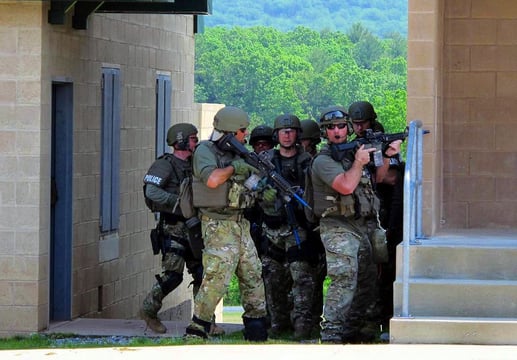The dust is just settling off this recent school shooting at Umpqua Community College. There’s villains, there’s heroes, and the shell casings haven’t even been picked up off the ground before politicians swooped in to muddy the already troubled waters. Even the President of the United States is looking to build a case for amorphous “stricter measures”. If you look at the other side of the political arena, you’ll find plenty of memes, stand-up routines, and barbed materials saying, “look at Australia — they banned guns. That worked.”
Unfortunately, one thing people conveniently ignore is that gun violence doesn’t up and vanish with the wave of a pen upon freshly inked restrictions.
Conservative estimates place the number of firearms inside the United States to be anywhere from 270 to 310 million. Other studies point to one in three Americans own firearms. Actual figures are impossible and based largely on voluntary responses from random people. Why is that figure impossible to tally? Not everyone volunteers that sort of information. A lot of people don’t even want to be identified as a gun owner for their own personal reasons. There are a HUGE number of variables but it’s pretty safe to say that the tally number of 310 million firearms is close to a small fraction of the actual number in existence within the borders of the United States.
The adult-children who scream that all the firearms in the United States should be collected up, citing the “success” of such measures being implemented in Australia, fail to note the simple logistical hurdle presented in that.
When the gun ban went into effect in Australia, Australian authorities collected something to the order of 815,000 firearms — approximately a third of the national stock. Australian authorities acknowledged it would be altogether impossible to truly and fully collect up all the firearms and they were largely able to identify households who possessed them because those households had registered some or all of those guns.
In the United States, we do not have uniform registration of firearms. Theoretically, the ATF may or may not attempt to track every gun purchased across the counter but then there are auctions and private sales which largely negate any full effect of that registry. The ATF even acknowledged that they do not possess the capabilities to fully track every registered gun in the United States.
So, let’s do a thought experiment: all firearms in the United States must be registered and all the firearms that don’t fall into some arbitrary set of rules must be turned in for fair market value.
Condition 1: States With Registries Will Use Those Registries
All states that require gun owners to register their firearms with the police will have immediate knowledge of who likely has a registered gun. All states that maintain a database of who carries a concealed firearm legally will know who likely has at least one gun.
Right off the bat, those are the first people that will be asked to voluntarily turn in their weapons. Because many of those people have families depending upon them and a job, yadda yadda, a good number may indeed show up and turn in some or all of their firearms.
A good number of gunowners would likely say, “oh that gun? I got rid of that thing years ago. Sorry… I can’t find a sales receipt for it. It’s been years now.”
And some of those gunowners may actually be telling the truth. It would be impossible to know.
Condition 2: Not All States Will Comply
That’s right. Remember when Colorado and Washington said, “hey folks, marijuana is legal and we don’t acknowledge the Federal government’s classification of that substance as a Schedule 1 drug?”
Guess what? States can say the same thing if the Federal government passes mandate for the limitation and/or collection of firearms. All it takes is one or two states to not comply and you have a loophole so big that you can effectively kiss any measure or mandate sayonara. Sure, the Federal government will use its usual scare tactics of threatening to withhold funding for something like education or transportation — similar to what happens when a state lowers its drinking age beneath 21 — but ultimately the state is beholden to its own citizens.
Condition 3: Constitutionality Of Any Such Measure Would Be Contested In A Court Of Law
Of course, when that Federal measure goes into effect, it will immediately be taken up in the courtroom. Surely, the Federal government will attempt to lengthen and obfuscate the court case but any such undue restriction as a “gun collection”, will be fought tooth and nail in the court of law. The Brady Act of 1994 severely violated and infringed upon the 2nd Amendment. In 1994, many hoped that such infringement would be rewarded with a safer society — it wasn’t.
The Federal government succeeded in implementing it solely because so many states willingly complied.
Condition 4: The ATF Needs To Be Expanded For Enforcement
In order to comply with the conditions of any measure restricting the 2nd Amendment further than it already is, you would need to hire A LOT more ATF task force members. We’re a nation of at least 270 million firearms. You’re going to need a lot of new additions to the team to keep up with registration, inventory, and enforcement.
No federal employee works for free. He’s paid a reasonably great salary, decent health benefits, and retirement. Also, if he’s injured in the line of work — we’re all on the hook to support him for the rest of his life.
Let’s just go ahead and say we’re looking at an addition of 12,000 ATF employees to the roster (and 36,000 Federal contractors) to just begin this process. If there are 270-310 million firearms in the United States, you’re going to need a LOT of Federal manpower to enforce that set of laws… Especially if not all 50 states (and Puerto Rico) comply.
Rationale (By The Numbers)
In a normal workplace environment, you have a pyramid of lower-paid federal employees supervised by mid-grade and then superiors. Let’s do a 1:10 ratio for high-to-low and a 1:5 for mid-to-low. So for every additional 10 ATF agents you take on board, you’re going to need 2 of them to be mid-grade team leaders (GS 10+) and 1 to be upper echelon (GS 15+). Lowers are paid, on average, GS 5-10 wages. Let’s average that at $38,500 annually for each set of 7 out of 10 new ATF employees. That’s extremely low-balled. After health benefits, matching 401ks, disability, and unemployment — it’s conservatively closer to $60,000 per. That brings your underlings a grand total of ~$420,000 per pack of 7.
2 mid-grades at $61,000 per ($110,000 after benefits, etc.) — $220,000.
1 upper at $101,000 ($162,000 after benefits) — $162,000.
So for each 10 new employees you bring on board, you have a residual yearly commitment to pay $802,000/year. That doesn’t cover travel expenses, per diem, training, or equipment. That’s just 10 bodies in through the door.
Your additional workforce will likely cost $9.6 billion dollars annually. That’s more than the annual budget (FY 2014) of the Federal Bureau of Investigation.
You’ve just quadrupled the size of the ATF and increased their operating budget to ten times what it was in FY 2014.
Not counting Federal contractors. Not counting anything else other than just bodies.
All this to collect up the guns and enforce tight gun control features. The ATF just became one of the most expensive arms of the Federal government.
Let’s just say: that’s not even realistic.
Conclusion: Yes, We Have One
When you hear a politician say, “I want greater restrictions on guns” — he or she is essentially saying that something has to be said to placate the coddled masses screaming for gun reform. You can’t make all the guns go away. And you can’t immediately implement sweeping gun reforms. Implementing a “Brady Act of 1994”-esque style of legislation is also pretty unlikely given the pervasiveness of firearms in this country and the lack of compliance on the State and local levels.














